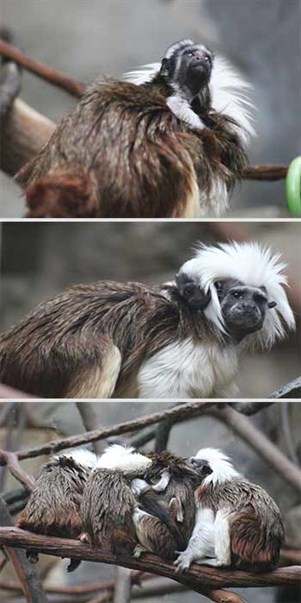Cotton-top tamarin baby born at Franklin Park Zoo
Thursday March 16, 2017
Visitors to Franklin Park Zoo’s Tropical Forest can look for a tiny, new furry face following the recent birth of a cotton-top tamarin. This birth is one more important step in helping to save this critically endangered species.
 Born March 3, the cotton-top tamarin baby, whose sex is not yet known, can be seen on exhibit with its mother Wilma, father Federico (Fred) and siblings Pebbles, Betty, and Lupita.
Born March 3, the cotton-top tamarin baby, whose sex is not yet known, can be seen on exhibit with its mother Wilma, father Federico (Fred) and siblings Pebbles, Betty, and Lupita.
“We are closely monitoring the mother and baby, but so far the baby is doing well and appears bright, healthy and alert. If visitors look closely, they will be able to see the baby clinging tightly to its mom’s back. Cotton-top tamarins are extremely social, and this new addition is very popular within the group,” said Josh Meyerchick, Assistant Curator of the Tropical Forest at Franklin Park Zoo.
Zoo New England participates in the Cotton-Top Tamarin Species Survival Plan (SSP), which is a cooperative, inter-zoo program coordinated nationally through the Association of Zoos and Aquariums (AZA). SSPs are designed to maintain genetically diverse and demographically stable captive populations of species. This birth is the result of a recommended breeding. Wilma did give birth to twins, but sadly one did not survive.
These small primates can be found in the understory and canopy of the tropical forest in northwestern Colombia. About the size of a squirrel, these small monkeys are noted for their long whitish crest of hair stemming from the forehead to the nape and flowing over their shoulders. Cotton-top tamarins are monogamous and groups typically include a dominant mated pair, their young, and a few subordinates and young. Their diet consists primarily of insects and fruit, and they play an important role as seed dispersers and pollinators in tropical ecosystems. In the wild, cotton-top tamarins face threats including loss of habitat and the illegal wildlife trade.
Zoo New England has supported Proyecto Titi, a program focused on cotton-top tamarins that combines field research, education initiatives and community programs to make the conservation of natural resources economically feasible for local communities in Colombia – the native home of cotton-top tamarins.
Learn more about cotton-top tamarins.

